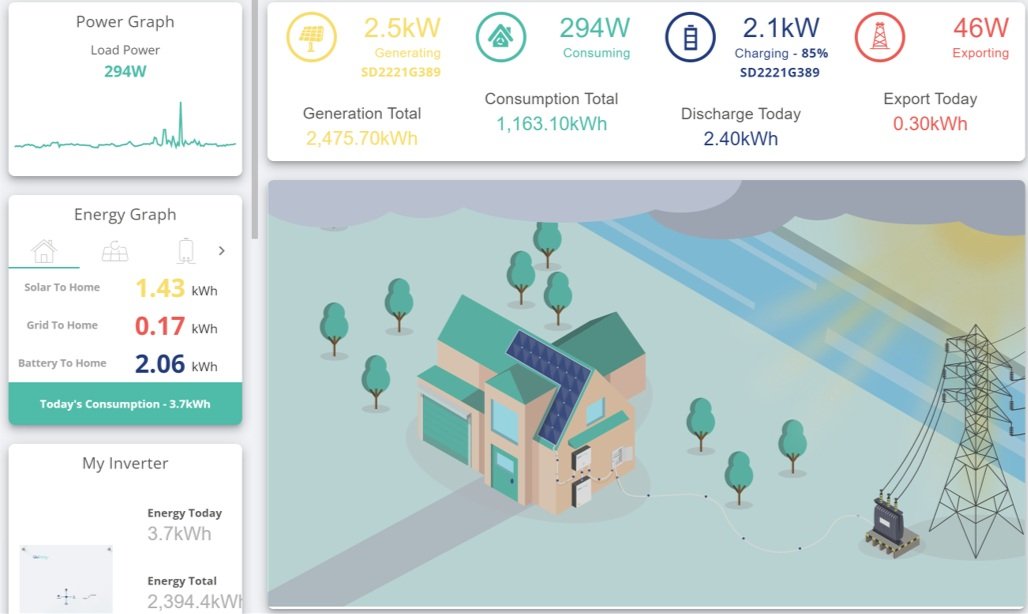Why an TEMOS is essential to maximise the efficiency of any solar system
Most Solar, Battery and EV Chargers are installed by electricians who are very good at electrical cabling and ensuring that an electrical installation conforms to the latest electrical standards. With most, if not all Solar installations a customer is handed a pack of information of about their installation and maybe shown how to download and use an app to monitor their system.
The Tewdric Energy Management Optimisation Service (TEMOS) has now become an essential component of a Solar install. Our service not only continually monitors the status of a system but we also modify settings to maximise production and utilisation. This service massively improves system performance and shortens the return on investment period.
With a non Tewdric Solar install the first part of a customer journey is an initial quotation or proposal. This usually involves a proposal that includes a lot of data about how much energy a system should produce and how much money that will be saved each year. Most proposals look thorough but most are based upon assumptions that cannot be guaranteed and are therefore obviously not 100% accurate. You may be thinking, well everyone uses the same assumptions so one proposal is just as accurate as another. You would be mostly correct in thinking this. However most of these proposals are designed to comply with the standards set out by the various certification bodies such as MCS and RECC. So realistically everyone provides you with the same information. Most proposals are also based upon comparisons with previous consumption of electricity data. However going forward who knows what your consumption will be especially if you are adding an electric vehicle to your household or fleet. To actually meet or exceed these predictions you would need your system to be 100% efficient at all times, need energy prices to keep increasing and hopefully for it to be sunnier that usual, not to mention no change to your consumption profile. The only option there that is pretty guaranteed is energy prices increasing. BUT you can actually improve your chances of meeting, if not beating the predictions without having to resort to praying for sunnier weather, hoping that your system functions without intervention, flawlessly and/or your consumption not changing for next 20+ years.
Typical Solar systems can have their configurations modified to suit a consumers particular requirements. Ideally you would be monitoring your usage and adapting your systems configuration on a daily or even hourly basis. However to spend that much time configuring your system would be very time consuming so nobody does that. In fact we have found that most Solar owners have not modified their system settings since the original installation and the vast majority only change their settings a few times a year when initially installed, changing to once or twice a year after the second year of install. Plus many do not spot problems with their systems for days, weeks or even months. In fact in some cases consumers have never checked that their system is actually producing the energy that it should be since the original installation. All of this means a typical system is losing money and/or not maximising efficiency.
Many new Solar systems are now installed with battery storage systems. Normally these will store excess solar production and then release the power when the solar power doesn’t cover the consumption of the property, usually at night. However the levels of Solar production varies massively over the year and can vary widely from day to day. Most battery systems include some basic scheduling settings but these need constant monitoring and frequent changes to work at maximum efficiency. Most installers don’t explain this.
The TEMOS will monitor the critical components of a system such as Inverters, Power Control Systems, Batteries, Optimisers etc. Should an essential piece of equipment stop functioning correctly we can try and remotely correct and restart the equipment. Some errors or failures will require a manual intervention and consumers can be guided through the restoration/correction procedures. A few issues may require a site visit by one of our professionals but this can be managed through the service. In addition the production, storage and utilisation data is analysed and system configuration changes made to improve performance. Every site has a unique system production and consumption profile. One example is the huge potential for efficiency gains through time shifting energy where cheap energy at off-peak times is imported and stored in batteries for later use when prices are high. Eventually the system will also adjust and account for energy trading opportunities where energy could be sold at peak prices and imported when prices are low at any time of day. This service will be offered to customers and will become good revenue opportunities especially for those with larger batteries and/or electric vehicles.
The TEMOS can save residential customers hundreds of pounds or even thousands of pounds a year with larger systems. For commercial customers the gains are usually much bigger. Once the energy trading opportunities are available the possibility of revenue generation of a system are potentially significant.
Tewdric Energy can offer retrofit opportunities to non Tewdric installed solar systems however the costs vary. In another blog we have explained how the costs for systems vary widely and if a system has not been designed with certain characteristics then retrofit costs will be higher. In cases of very low cost installs the systems are unlikely to be suitable for the service. But for commercial installations it would usually be worth adding our service even if there is a significant upfront cost to adapt an existing system.
If you are thinking of installing a Solar system or would like to maximise your ROI on an existing system please get in touch and one of our experts will be able to discuss your requirements.




